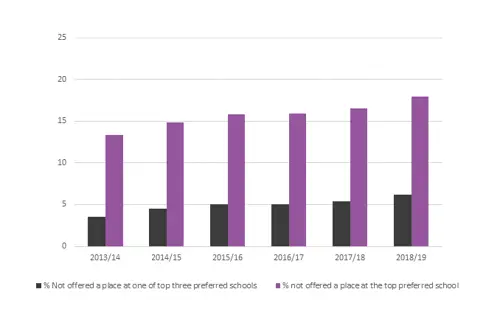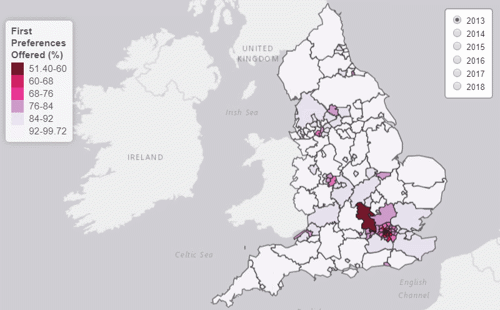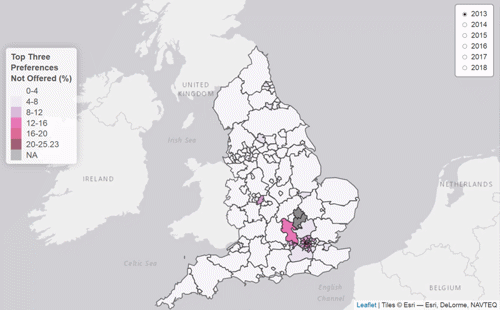Choosing a secondary school: school allocations and tips for parents
Thursday 11 October 2018
At this time of year, many families with a Year 6 child are busy spending evenings visiting or researching their local secondary schools. Parents are likely to be spending lots of time debating the relative pros and cons of the schools they are viewing, assessing which will be the best fit for their child, and anxiously worrying about their chances of being offered a place at their preferred school. The cause of all of this frantic activity is the looming 31 October deadline, when parents with a Year 6 child need to inform their local authority (LA) about their preferred secondary school choices.
In this blog, we take a look at what has been happening with secondary schools applications in recent years and provide some tips for parents who are making their applications.
How the secondary school admissions process works
In England, parents of Year 6 pupils choose, in order of preference, between three and six [1] secondary schools that they would like their child to attend the following September. Families then submit these preferences through their LA which is responsible for administering the allocation of school places (Weldon, 2018).
As parents are able to make multiple choices, schools generally have more applications than they have places. When this happens, the LA ranks all children who wish to attend the school against the school’s published admissions policy. Admissions policies vary considerably between schools with some, for example, prioritising siblings, children of a particular faith or those with particular talents above others (Weldon, 2018). These criteria are used, in conjunction with family preferences, to allocate each child to a school. A child will be offered a place in their highest preference school, where they rank high enough on the admissions criteria to be considered for a place. If families do not submit any preferences
or their child does not rank highly enough in any of the schools they have requested, the family is directed to a school with available places. This is done after the preferences of all other families have been taken into account.
How have families been faring with getting their top choices?
In 2018, just over four in every five families were offered a place at their preferred school. As Figure 1 shows, there has been a gradual decrease of 4.6 percentage points in the percentage of families being offered their first preference school since 2013, suggesting that competition for good secondary school places is increasing. Furthermore, the percentage of families not receiving any of their top three preferences has increased by 2.7 percentage points since 2013 to 6.2 per cent in 2018.
Figure 1: More families are not being offered places in their preferred schools

The national picture masks considerable geographical variation
The chances of getting a place at your preferred school varies considerably across the country, and appears particularly difficult in urban areas. In 2018, only 51.4 per cent of families in Hammersmith and Fulham were allocated a place at their preferred school, compared to 98.1 per cent of families in Northumberland. All of the 20 per cent lowest ranking LAs, in terms of the proportion of families getting their first preferences, were in urban areas. As Map 1 below shows, many LAs around the country have seen a drop in the percentage of families receiving their first preference since 2013.

The proportion of families not being offered a place in any of their top three preferred schools also varies considerably by geographic area. In Kensington and Chelsea, nearly one-fifth of families were not offered a place in one of their top three schools, compared to Wigan where only one per cent of families failed to get one of their top three choices. The bottom quintile of LAs, in terms of the proportion of families not receiving a top three preference, were again in mainly urban locations.

Maps produced by Stephen McNamara
Tips for parents
There are a few tips that families should bear in mind when deciding which secondary schools to express a preference for:
- First and foremost, make sure you do your research about your local schools, visit them if you can and carefully read the LA secondary school admissions booklet.
- List the schools you want in order of genuine preference. Places are allocated through an ‘equal preference’ system, so the order of preference does not affect your likelihood of being offered a place.
- Ensure that you state as many preferences as possible (to minimise your chances of being ‘directed’ to a school you don’t want).
- Do not write the same school into each box, as this will not increase the chance of being offered a place there.
- Avoid filling your list with good schools which are a long way away and are very popular as you may not get any of your choices. Try to express a preference for at least one school that is likely to offer you a place.
- Make sure you submit your application form by the 31 October deadline.
Good luck!
To find out more about the secondary offers process in your area click here and enter your postcode.
To compare secondary schools in your area click here to use the DfE’s compare schools tool.
_____________________________
[1] The number of choices parents are offered will vary by LA. Parents in metropolitan areas such as London tend to have more choices.
